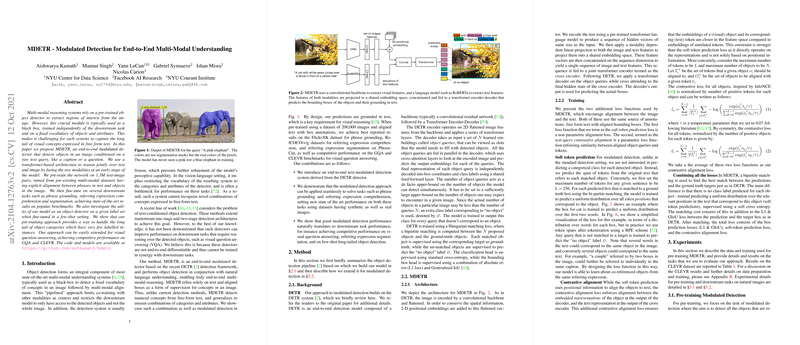MDETR: Modulated Detection for End-to-End Multi-Modal Understanding
The paper entitled “MDETR: Modulated Detection for End-to-End Multi-Modal Understanding” presents a novel approach aimed at addressing the integration of multi-modal reasoning systems. Traditional systems often rely on pre-trained object detectors, independently trained and limited to a fixed vocabulary, creating challenges in capturing a wide spectrum of visual concepts. MDETR introduces an end-to-end modulated detector that conditions object detection on a raw text query using a transformer-based architecture, facilitating a more robust synergy between visual and textual information.
Methodology
MDETR leverages a transformer framework stemming from the DETR model, employing a convolutional backbone for the visual features and a pre-trained LLM such as RoBERTa for the text features. Both sets of features are projected into a shared embedding space and processed through a joint transformer encoder, followed by a transformer decoder that outputs bounding boxes of objects along with their textual grounding.
Training and Loss Functions:
- Soft Token Prediction Loss: Aimed at predicting the span of tokens from the corresponding text for each object detected, encouraging fine-grained alignment between the visual and textual data.
- Contrastive Alignment Loss: Enforcing similarity between embeddings of image objects and their textual counterparts, operating directly in the embedding space to ensure robust alignment.
MDETR is pre-trained on a dataset comprising 1.3 million text-image pairs from datasets like MS COCO, Visual Genome, and Flickr30k, ensuring varied and dense annotations. The model is further fine-tuned on specific downstream tasks, including phrase grounding, referring expression comprehension, segmentation, and VQA.
Experimental Results
The paper evaluates MDETR on several benchmarks to demonstrate its efficacy:
- Phrase Grounding: Achieved a notable improvement of more than 8 points in Recall@1 on the Flickr30k entities dataset using the Any-Box protocol, setting a new performance benchmark.
- Referring Expression Comprehension: Significantly outperformed previous state-of-the-art models across RefCOCO, RefCOCO+, and RefCOCOg, which are indicative of the model's ability to accurately localize objects based on complex linguistic descriptions.
- Referring Expression Segmentation: In the PhraseCut dataset, MDETR demonstrated substantial gains in mean IoU and precision metrics, showcasing its capability to produce precise segmentation masks grounded in textual queries.
- Visual Question Answering (VQA): On the GQA dataset, MDETR not only surpassed models with comparable pre-training data but also demonstrated competitive performance against models utilizing significantly larger datasets.
- Few-shot Long-tailed Object Detection: When evaluated on the LVIS dataset, MDETR exhibited strong performance in few-shot settings, particularly excelling in rare category detection—highlighting its potential in applications requiring adaptability to sparse annotations.
Analysis and Implications
Strong Numerical Results:
- The improvements in Recall@1, accuracy, and mean IoU in various tasks underline the high performance and robustness of MDETR across different contextual scenarios.
Impact on Future Research and Development:
- The end-to-end nature and early multi-modal fusion employed by MDETR pave the way for more integrated designs in multi-modal learning.
- The success in handling the long tail of visual concepts invites further exploration into sparsity-focused learning techniques in the context of large-scale multi-modal datasets.
Future Directions:
- Investigating model scalability with even more extensive and varied datasets can potentially push the boundaries further in both generalized and specialized tasks.
- Extending the framework to incorporate dynamic and interactive environments, considering the context of robotics or real-time assistive technologies, poses an interesting avenue for future research.
Conclusion
The introduction of MDETR provides a significant contribution to the domain of multi-modal understanding. By employing an end-to-end differentiable architecture with early fusion of visual and textual features, the paper successfully demonstrates the advantages of a more integrated and context-aware approach to reasoning with multi-modal data. MDETR's robust performance across various benchmarks validates the effectiveness of modulated detection and lays a strong foundation for future advancements in this field.
